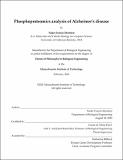Phosphoproteomics analysis of Alzheimer's disease
Author(s)
Morshed, Nader Francis.
Download1252627422-MIT.pdf (16.66Mb)
Other Contributors
Massachusetts Institute of Technology. Department of Biological Engineering.
Advisor
Forest M. White.
Terms of use
Metadata
Show full item recordAbstract
Alzheimer's disease (AD) is a form of dementia characterized by the appearance of amyloid-[beta] plaques, neurofibrillary tangles, and inflammation in brain regions involved in memory. Despite numerous clinical trials, a limited understanding of disease pathogenesis has prevented the development of effective therapies. Several lines of genetic and biomolecular evidence indicate that AD progression involves cellular signaling through neuronal and glial protein phosphorylation networks. In order to understand which phosphorylation networks are dysregulated, I use mass spectrometry to characterize the phosphoproteome of post-mortem brain tissue from AD patients and multiple mouse models of AD. Using computational analysis, I identified several signaling pathways that are dysregulated before neurodegeneration occurs. Many of these signaling factors were expressed primarily in non-neuronal cell types, including microglia, astrocytes, and oligodendrocytes. My results highlight potential therapeutic targets in the signaling responses of glial cells and are split into two parts. In the first part of this thesis, I have quantified the phosphoproteome of the CK-p25, 5XFAD, and Tau P301S mouse models of neurodegeneration. I identified a shared response involving Siglec-F which was upregulated on a subset of reactive microglia. The human paralog Siglec-8 was also found to be upregulated on microglia in AD. Siglec-F and Siglec-8 were upregulated following microglial activation with interferon gamma (IFN[gamma]) in BV-2 cell line and human stem-cell derived microglia models. Siglec-F overexpression activates an endocytic and pyroptotic inflammatory response in BV-2 cells, dependent on its sialic acid substrates and immunoreceptor tyrosine-based inhibition motif (ITIM) phosphorylation sites. Related human Siglecs induced a similar response in BV-2 cells. Collectively, my results point to an important role for mouse Siglec-F and human Siglec-8 in regulating microglial activation during neurodegeneration. In the second part of this thesis, I performed a combined analysis of the tyrosine, serine, and threonine phosphoproteome, and proteome of temporal cortex tissue from AD patients and aged matched controls. I identified several co-correlated peptide modules that were associated with varying levels of Tau, oligodendrocyte, astrocyte, microglia, and neuronal pathologies in different patients. I observed phosphorylation sites on known Tau-kinases and other novel signaling factors that were correlated these peptide modules. Finally, I used a data-driven statistical modeling approach to identify individual peptides and co-correlated signaling networks that were predictive of AD pathologies. Together, these results build a map of pathology-associated phosphorylation signaling events occurring in AD.
Description
Thesis: Ph. D., Massachusetts Institute of Technology, Department of Biological Engineering, February, 2021 Cataloged from the official PDF version of thesis. Includes bibliographical references (pages [137]-[153]).
Date issued
2021Department
Massachusetts Institute of Technology. Department of Biological EngineeringPublisher
Massachusetts Institute of Technology
Keywords
Biological Engineering.